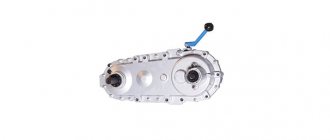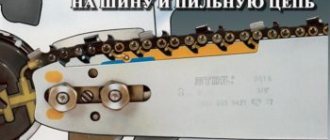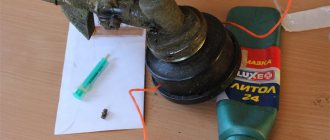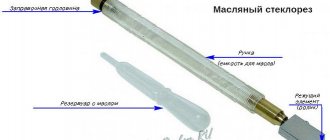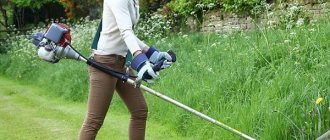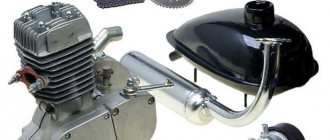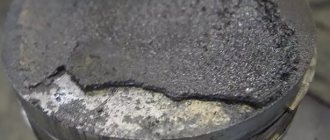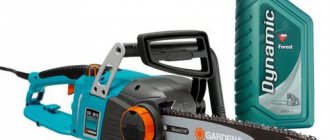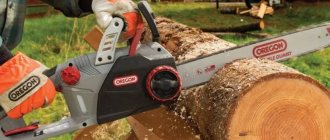Availability walk-behind tractor in personal farming, few people can be surprised, because this technical device has been known since Soviet times. Thanks to him it became possible fast and high-quality soil cultivation, which previously took quite a long time and also took a lot of effort.
However, in order for your walk-behind tractor, as they say, to serve you faithfully, regularly plowing the ground and performing its other functions, you need to operate it correctly.
In particular, you need to know how much oil to pour into the gearbox of a walk-behind tractor so that it works in optimal mode, and its parts do not wear out due to the lack of necessary lubrication.
In principle, all the necessary information, as a rule, is indicated in the operating instructions for a specific walk-behind tractor model, where the brands and grades of recommended oils are directly indicated.
However, there are cases when a walk-behind tractor is purchased by hand or in another way, but the point is that such walk-behind tractors are supplied, basically, without any instructions.
A person may be at a loss, not knowing what kind of oil is poured into the gearbox of a walk-behind tractor, so it will be useful for him to know about its main types, as well as how to fill it into a walk-behind tractor.
Classification of oil grades
To increase the service life of a gasoline or diesel engine, you need to make the right choice of engine oil. Failure to replace it in a timely manner reduces the service life of the engine. How to choose it, in what quantity, how to pour it into the walk-behind tractor - we’ll talk about this in more detail.
Each mini-tractor or walk-behind tractor includes instructions and a product data sheet. In the instructions, the manufacturer lists suitable types of fuel and lubricants that can extend the life of the equipment. Engine oil performs the following functions:
- cooling;
- lubricants;
- seals;
- cleaning.
During air cooling, the lubricant settles on the walls of the hot cylinder. These deposits contaminate engine parts and complicate lubrication processes. Therefore, the lubricant contains antioxidant additives. They clean the cylinder walls from carbon deposits and extend the service life of the walk-behind tractor. Different climate zones require the use of different oily liquids. They differ in viscosity, composition and purpose.
By viscosity
Viscosity is determined according to SAE J300 standard. For mechanisms it depends on the following characteristics:
- unit design;
- features of work;
- age of the mechanism;
- ambient air temperature.
Motor oils are divided into winter and summer. Winter ones are designated with the letter W. Low-viscosity winter grades are often used with SAE designations 0W, 25W, as well as intermediate values 20W, 5W, 15W and 10W. Compositions for use in summer do not have letters in their names. They are distinguished by high viscosity and are designated SAE 20, 60, SAE 30 or 40. When using summer brands in winter, problems arise associated with starting the unit. Winter varieties are not capable of providing high-quality lubrication in the summer.
Scientists have developed all-season compositions that are used for pouring into walk-behind tractors in summer and winter. Their designations are 5W-40, 10W30.
By composition
In addition to seasonal characteristics, lubricants are divided into types based on composition:
- mineral;
- synthetic;
- semi-synthetic.
An air-cooled engine heats up quickly during operation. Motor oil reduces its temperature. The wrong category causes a breakdown in the motor. It is not recommended to use synthetic oil in mixture with mineral oil.
By purpose
If there is a need to replace lubricating fluids, each manufacturing company recommends filling in its own brand. For agricultural machines, Honda uses all-season grades 10W-30 of the SF category. Subaru in its recommendations indicates 10W-30 for operation in moderate climates, and 5W-30 in cold regions. Oil quality category - SE.
Lifan products require summer grade SAE-30, and SAE 10W-30 for winter conditions. There are no conditions for quality category. Motoblocks of the Kaluga Engine company are filled with an all-season composition 10W-30 or 15W-30 of SF or SH quality.
Peculiarities
When choosing this element, the soil to be cultivated plays an important role. Thus, a chain gearbox, like a worm gearbox, performs well on light soil - black soil and sandstone.
If the site is composed of heavy loams, especially full-fledged clay, it is recommended to choose between chain and gear devices.
The worm version is suitable only for lightweight and especially light cultivators that will cultivate well-groomed plots of up to 6-8 acres. This method of energy transfer occurs due to the coupling of the screw with a wheel covered with teeth of a special profile. When the worm (as the screw is called) rotates, the thread moves along its axis. The teeth are pushed in the same direction at the same time. The main part of the wheel spins, and the cutters also receive an impulse from it.
The main properties of this design are:
- smooth movement of the cultivator;
- faint noise;
- cost savings;
- low efficiency;
- excessive heating and powerful waste of oil;
- small resource;
- inability to use reverse mode and add attachments.
Most of the latest model cultivators use chain gearboxes. Simplicity is considered their important advantage. There is only a chain and a pair of sprockets: one at the bottom (mounted on the shaft), and the other at the top.
It is worth remembering that chain gear units can be non-separable; they are used if areas of no more than 15 acres are to be processed. In this case, the device’s lifespan may exceed 10 years.
Even experts cannot name the obvious disadvantages of a chain gearbox. But its advantages are obvious:
- minimal energy loss between the motor and cutters;
- affordable price;
- relatively narrow body;
- simple maintenance;
- the ability to reverse.
If reliability comes first, you should give preference to a gear design.
In most cases, it contains 3 to 5 gears in a closed but disassemblable housing. Such devices perform very well in heavy-duty cultivators. They are even used in walk-behind tractors designed to cultivate land with an area of over 25 acres. But it is important to understand that the cost of gear reducers is very high.
What kind of oil to pour into a walk-behind tractor engine
Manufacturers of walk-behind tractors and mini-tractors prescribe the use of motor oils for both gasoline and diesel products. The motors are being tested at the factory. At this time, lubricants are used that are recommended in the instructions. Some manufacturers recommend their own brand of oils. The Patriot walk-behind tractor is equipped with an engine of the same name and requires Patriot 5W30 SJ/CF, Patriot Supreme HD SAE 30 4T oil.
For gasoline engines
For walk-behind tractors running on gasoline, it is recommended to pour the following types of liquids into oil containers:
- SA - for work with low loads;
- SB - for work with medium mechanical load;
- SC - used in engines without PCV valves;
- SD - works in engines with PCV;
- SE - lubricant for use in engines manufactured since 1980;
- SF is a higher quality analogue of the previous oil;
- SH - used in many engine systems.
Category SB has good anti-corrosion properties. The product efficiently lubricates cylinder walls and bearings. SF reduces the amount of oil deposits in 4-stroke and two-stroke engines.
For diesel engines
With the recommended motor oil, owners increase the resource of the unit and reduce diesel fuel consumption for a diesel walk-behind tractor. The instructions for a walk-behind tractor with a diesel engine indicate the following categories of lubricants:
- SA - for working with low loads;
- SV - for working with high-sulfur fuel;
- CC - for a non-turbocharged engine operating under increased loads.
Category CA reduces the amount of carbon deposits in the cylinders, but reduces the quality of the lubricant. Any lubricant is poured in the required volume. Reducing or increasing it leads to jamming of the motor.
Main types of cultivators
Before purchasing any cultivator, you need to understand its types and species diversity (capabilities):
- light - used in cultivating land plots with an area of no more than 12 acres. Such cultivators are easy to move because they weigh little (up to 30 kilograms). Perhaps their most significant drawback is that they are not able to cultivate the soil at great depths (the depth should be no more than 20 cm);
- medium - these weigh more (up to 90 kilograms) and can cultivate a larger area (up to 50 acres);
- heavy - this type speaks for itself, these are cultivators weighing more than 90 kilograms. Heavy cultivators have one excellent ability: a variety of additional attachments can be attached to them, which increases the technical capabilities of the unit several times.
According to the type of built-in engine, cultivators are divided into:
- gasoline - their main advantage is reliability during operation, but there is also a disadvantage - the cost of purchasing fuel.
- Electric cultivators are their strong point in simplicity and ease of control. But these units can process not very large areas and not far from the house, since they are dependent on a source of electricity. The length of the power cord plays an important role in their mobility, and for good operation they need a high-quality electrical network - without power surges..
- battery-powered ones are the main “trump card” of these types of cultivators, they are mobility and independence from electricity and any type of fuel (after charging they can work autonomously for a long time).
When choosing a cultivator, always be guided by the area of your plot. For small areas, it’s a good idea to opt for an electric cultivator; by the way, it works very well in greenhouses and flower beds. For a large plot of land, take a gasoline one (medium or heavy type), but immediately stock up on funds to refuel it, or you can take a battery-powered one (however, it is inferior in power to gasoline).
When you buy, be sure to try on the equipment; the handles of the device should be comfortable and made of high-quality material, and their surface should be covered with roughness so that your hands do not slip while operating (especially important in hot weather). All control devices must be visible and easy to use
The main thing is convenience when working with the equipment and further proper care of garden equipment.
What kind of oil to pour into the walk-behind tractor gearbox
Each walk-behind tractor contains a gearbox. It also uses gear oil, which is changed regularly. Today there are mechanisms in which there is no need to change the oil. To replace, you need to use transmission compounds. This will extend the life of the unit. The gearbox of the Neva MB-2 walk-behind tractor requires transmission substance TEP-15. It operates in summer at air temperatures from -5˚С. For winter, fill in TM-5. It can withstand up to -25˚С. Volume - 2.2 l.
For the Neva MB-1 unit you need to prepare TAD-17I or TAP-15 V. The volume of lubricant is 1 liter. Salyut 5 and Belarus 08N-09N uses M-10V2 and M-10G2 in warm weather. In winter - M-8G2. The Oka MB-1D1 is filled with the TAD-17I or TAP-15 V transmission. The gearbox of the Tselina MB walk-behind tractor is filled at the factory. No lubricant change required. Tarpan is refueled with TAD-17I or its analogues. The favorite is MS-20 or TAD-17I aviation oil.
Vario requires replacing 80W90 every two years. The best oil for the Patriot Garden unit is 85W90. The recommended composition for the Zubr gearbox is TAP-15.
A few words about the timing of replacement. In the Favorit gearbox, the first replacement is made after 25 hours of operation. Thereafter it is changed every 250 hours. Replacement works better on a hot engine. The hot waste is drained through the oil drain, and fresh is poured in through the fill hole.
In the Tselina device, the contents of the gearbox are first changed after 50 hours of operation, then every 200 hours. Ugra and Oka are replenished daily with a small amount. A complete replacement is done after 100 hours of operation.
Device
The trimmer gearbox includes 2 shafts - the first is driven by the engine, and the other is used to rotate the cutting blade of the brush cutter or electric trimmer line. Bevel gears are made as a single unit with the shaft, but there are versions with the installation of a separate part on a spline connection. Models are available with different tooth angles, which depend on the layout of the tool. There are modifications of gearboxes with worm, planetary or mixed (multi-stage) gears.
The shafts are mounted on rolling bearings, which are covered with protective washers. The parts ensure the preservation of lubricant and prevent dirt from entering the work paths. The bearings are installed in a gear housing made of aluminum alloy. The unit is detachable and consists of 2 symmetrical halves, which are connected to each other with screws. To ensure the tightness of the joint, a separate gasket or sealant is used.
The lower gearbox for the trimmer is installed on the tool through a mounting socket. There are several types of joints, differing in shape.
There are modifications of the tool with square or polyhedral joints of elements. Torque transmission is carried out through a splined connection.
What kind of oil to fill in Neva walk-behind tractors
The quality of the lubricating fluid in the walk-behind tractor gradually decreases and becomes unusable. Along with this process, engine wear occurs. To prevent wear and tear, lubricant mixtures must be changed promptly. The instructions indicate the recommended brand and quantity. When purchasing, you must take into account the level of its viscosity and quality classification. For the Neva walk-behind tractor, you need to purchase oil for the gearbox and engine.
The Neva walk-behind tractor is equipped with different motors. They require lubricants of different brands and manufacturers. They should be poured into the engine taking into account the viscosity and category. For example, the Neva MB-2 walk-behind tractor is equipped with an American Briggs (Bridge) engine, while the MB-23 is produced on the basis of Honda engines.
If a device with a Honda engine is purchased for a plot of land, it can be filled with SAE 10W-30 in summer and winter. The same universal remedy is suitable for the Lifan engine. Subaru produces lubricant for its equipment itself. With a Subaru engine you need to buy lubricant from the same company. Her brand is Ow20. It is suitable for winter and summer engine operating conditions. It is permissible to fill in 5w-30 from the same manufacturer instead.
The Briggs & Stratton engine is filled with SAE 10W-30 summer engine oil. For winter conditions, SAE 5W-30 is suitable. Its consumption is higher than that of other motors, so the level needs to be checked more often. If necessary, lubricant is added to the specified level.
The gearbox is an important part of the walk-behind tractor. For proper operation, it is necessary to fill the gearbox of the Neva walk-behind tractor with good quality oil and replace it periodically. These oils include TEP-15 and TM-5. Its volume is 2.2 liters. The hot used liquid is drained through a special hole and fresh is poured in. These types are suitable for MB-1 devices. When replacing, the unit is installed in a vertical position, and a container is placed under it to drain the waste.
On a newly purchased unit, the first replacement is made after 30 hours of operation, then every 180-200 hours.
If the walk-behind tractor is rarely used for work, replacement is done at least once every two years. The Neva MB-2 unit needs to be filled with TAP-15V oil; instead, you can use the TAD-17I brand.
You need to know when to change the oil. In a newly purchased unit, you need to check its level. Some walk-behind tractors are sold without lubricants. If necessary, you can add oil and run the device for 20-25 hours. Then replacement is made after 100-250 hours. The deadlines are indicated in the instructions.
Tips for use
To increase the service life of the snow blower gearbox, you should carefully read the advice of experienced professionals.
- Always use only high-quality gear oil for lubrication. If you lubricate the device with semi-synthetic analogues, the mechanism will quickly fail.
- Take ten-minute breaks after the snow blower has been running for an hour. This is necessary to ensure that the gearbox does not heat up too much and does not wear out prematurely.
- Clean the assembly regularly. Even when pouring high-quality oil, carbon deposits can accumulate on the walls, interfering with the ideal operation of the mechanism. If you use your snow blower regularly, you should wash it every two weeks.
- Be careful when pressing the auger drive lever. After all, with any pressing of the lever, the drive cable stretches. Therefore, pressing on the wire lever should only be used when absolutely necessary.
- Do not allow oil to leak from the gear housing. Check and replace all seals in a timely manner.
- Always inspect the snow carefully to ensure that foreign objects do not get inside the snow blower. They can damage the gearbox.
To learn how to replace a gear in a snow blower gearbox, watch the video below.
What kind of oil to pour into the Lifan walk-behind tractor
Choosing the right oil is the key to proper engine operation. In the instructions that come with the walk-behind tractor, the manufacturer always notes what kind of oil is needed for this engine.
The Lifan walk-behind tractor needs high-quality oil. For four-stroke engines, it is prohibited to use oil suitable for two-stroke engines. It should also be without additives.
For Lifan walk-behind tractor with 6.5 hp engine. SAE 5W-30 oil is required with the gearbox. For most models with engines of different power (5.5 hp - 13 hp), SAE - 30 year old or all-season SAE - 10W-30 oil is suitable.
How to disassemble?
The gearbox must be lubricated as thoroughly as possible. Even noise can be eliminated if the deficiency of lubricants is replenished. But you should be as careful as possible when choosing a suitable brand of lubricant; the use of contaminated compounds is unacceptable.
It is worth considering that extraneous sounds are often associated with poor tightening of fasteners, wear of bearings and gears. To disassemble the gearbox, you need to:
- remove it;
- unscrew the screws;
- remove the protective caps;
- pull out the output shaft bushing;
- disconnect the lever and then the plug;
- remove the input shaft (in close connection with the gears);
- remove the shaft and chain bushings;
- dismantle the shaft and sprocket block;
- remove the intermediate shaft and gears;
- remove the coupling and axle shafts (assembly is carried out in the reverse order).
What kind of oil to fill in a MTZ walk-behind tractor with a Honda engine
MTZ walk-behind tractors have established themselves as high-quality agricultural equipment; in combination with the world-famous Honda engine, they have excellent performance characteristics.
For proper operation of the entire device, it is necessary to carry out timely technical inspection, including checking the oil level. What kind of oil should I use? Belorus 08H-09H walk-behind tractors with Honda GX 240, 270, 340 and 390 engines are suitable for oil classified no lower than SG and SF; all-season oil SAE 10W-30 is recommended, but under specific temperature conditions it is necessary to select a special oil.
Installation of a homemade or replacement mechanism
- If you plan to operate the cultivator as intensively as possible, angle energy converters should be used. But such a device is suitable only if the transmission and motor are connected through a chain. Reduction gearboxes (aka speed reducers) are installed only in conjunction with air-cooled engines.
- It is recommended to weld the housings of homemade devices from steel plates. In some cases, heavy truck shafts (like the Ural) are used instead.
- Launching homemade energy converters is done in exactly the same way as when using similar industrial designs. The first starts should not be carried out under high load.
To learn how to make a reduction gearbox without turning, see the video below.
No matter how high-quality the equipment for cultivating a summer cottage or garden plot is, it requires good care. Otherwise it may break quickly. Let's talk in this article about how to ensure good care and repair of the cultivator gearbox so that it serves its owners for as long as possible.
What is a gearbox?
